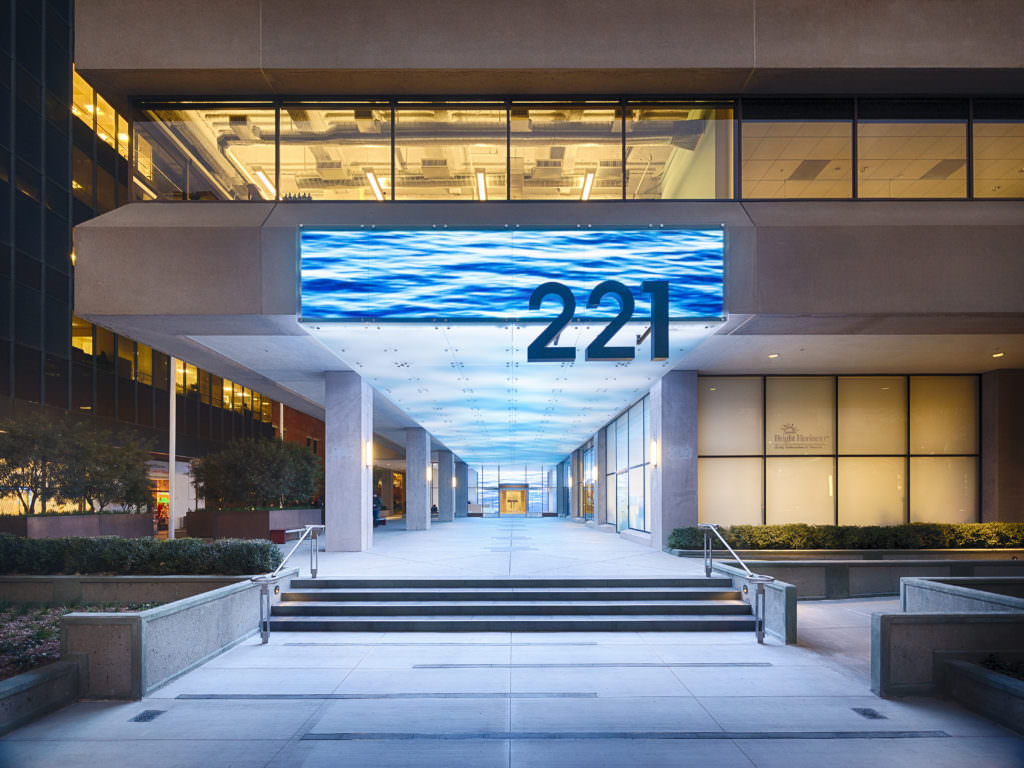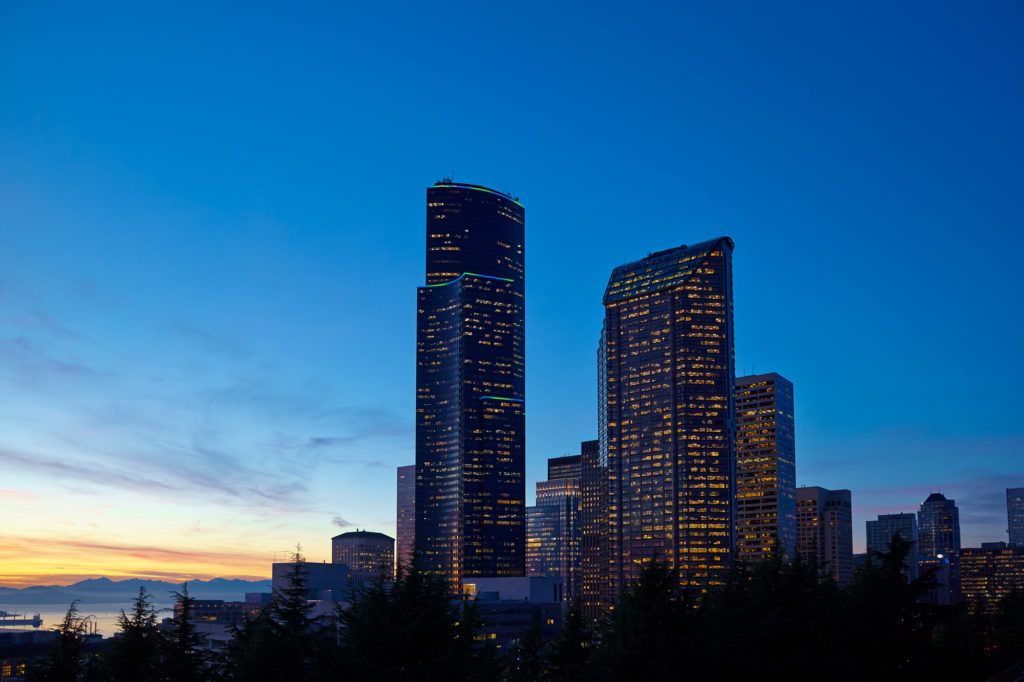Buildings in Conversation with the City
Posted July 9, 2020
Four Opportunities for Commercial Office Buildings to Build Connection and Conversation Among Tenants and the City Community
This article is co-authored by ESI Design’s Emily Webster and Chris Niederer, along with NBBJ’s Tim Johnson.
“Cities have the capability of providing something for everybody, only because, and only when, they are created by everybody.”
― Jane Jacobs, The Death and Life of Great American Cities
As our cities reopen following the pandemic, they feel much quieter than usual. The coronavirus has disconnected us from each other and our urban spaces. Given this shift, how can we re-engage with them in meaningful and effective ways?
One of the first places we will return to will be commercial office buildings, which can serve as powerful catalysts for reconnecting us with our communities. To create more engaged and healthier urban centers, our buildings can provide experiences that celebrate, amplify and augment these spaces. Below we outline a series of experience design ideas and strategies — which can easily shift and evolve — that commercial buildings could employ to reinvigorate civic life.
Rethink the Lobby
It is important to prioritize elements that reduce stress for tenants who return to the office building, beyond communicating social distancing protocols. One way is to employ nature’s science-backed calming effects. Numerous studies demonstrate looking at nature — even simulated — is proven to lower blood pressure and heart rate. Digital views of nature that respond to people’s movements can provide a rejuvenating enclave in a busy urban environment — and greet building lobby visitors with delight even when there is no front desk staff present. Immersive installations can provide a comforting animated landscape inspired by local surroundings, with digital flora and fauna welcoming and interacting with visitors as they walk by. Light installations can also simulate the supremely calming experience of sunlight hitting water ripples to create unique meditative moments.

These digital layers could be customized at any time, not only to create a livelier environment, but to act as a communications platform that offers an air of exclusivity never experienced before in a multi-tenant building. Lobby media architecture could be tailored for specific tenants to provide unique branding experiences. In a world with proposed timed tenant entries for high rises, lobbies of multi-tenant buildings could become intimately branded for one tenant’s arrival time via specific messages and graphics for their employees to create a more personalized experience. On the weekend, these displays could engage the surrounding neighborhood by showcasing local public art, environmental data, or educational information.
Meanwhile, digital installations can also reinvigorate lobbies in aging or historically-significant buildings, while also providing visibility to street passerby. Media architecture that changes with the weather, seasons, and other neighborhood inputs can bring dynamism and sophistication to urban icons that a static art piece cannot. Custom human-scale lighting installations can also bring warmth to landmark buildings and transform areas of frequent movement (people entering and exiting) into destinations too by inviting tenants to sit and take in the digital art.
Address the “Front Porch”
Consider the space outside your commercial building. How can you create a more welcoming presence that invites not just tenants, but passersby to stay and linger in a safe and socially-distanced manner? While a plaza filled with seating and chairs provide places for people to sit, consider an element of surprise or serendipity to maintain engagement. Temporary graphics and pop-up interactive digital “sculptures” which can also serve as seating, exercise equipment or play structures for children, can encourage people to explore and linger in their neighborhood throughout the week and weekend.
Design that engages the senses — through thoughtful and dynamic exterior lighting, soundscapes, landscaping and water features installed outside commercial buildings — could help reunite us with our cities. Interactive multistory digital façades can enliven barren spaces while offering a sense of respite for building tenants and the community. An LED light trellis can become a living wall, simulating dappled light through trees via data-driven animations. This type of installation can transform a former concrete wall into soothing lights to create a peaceful moment, both during the day and at night, at the center of a busy city.
Neuroscience shows “prospect and refuge” — the ability to both survey a space and also find shelter — is hardwired into our brains. More permanent exterior design solutions could provide this. For example, iconic entry canopies can protect people from the elements, while small roofed structures placed in plazas can create socially-distanced niches for reading, lounging and people-watching, as well as areas for farmer’s market stalls. To redefine the street-front, immersive digital entry portals can serve as a neighborhood anchor and branding experience. An exterior-interior multimedia installation can create a new identity that is both a lighting surface, content display and architectural enhancement. Unique digital displays can wrap around building exteriors and move into the interior to offer a dynamic media element that can evolve as needed. Etched glass layered on top of different LED resolutions can create a seamless digital experience that renews an aging building.

Be a Good Neighbor
To help reactivate the city and extend the network of building users on a daily basis, commercial buildings could host a series of rotating platforms that artists can use to enliven empty or underutilized commercial space. In addition to independent artists, these vacant commercial spaces could also allow cultural institutions to show more of their collections. In New York City, the Museum of Modern Art only has space to display 30% of its full collection — which contains more than 200,000 pieces — while the Guggenheim Museum only shows 3% of its works. By distributing these artworks throughout the city, taking advantage of newly released real estate, museums could utilize highly visible spaces and extend where and how people see art. For example, the Rijksmuseum store at Schiphol Airport in Amsterdam utilizes empty retail space, and was the first art museum in the world to open a new branch at an airport.
Art walks have long been a popular urban event. In this spirit, commercial buildings could go a step further and develop partnerships with local civic or business improvement districts (BID) or even each other to bring amenities outdoors and repurpose underutilized areas, sidewalks or vacated parking spaces for outdoor dining, pop-up retail and more. In New York, the Madison Square Park Conservancy produces a popular culinary pop-up market, Mad Sq. Eats, which draws local restaurants from around the city into an underutilized plaza. This program brings the kitchen to the street to not only create a welcoming public outdoor dining experience, but also bring greater visibility to the community and neighboring businesses.
Temporary educational signage posted on or near commercial buildings can also encourage people to reconnect with their urban communities. For example, sidewalk decals can provide self-guided tours that help people learn about the history and significance of local architecture. Philadelphia’s robust wayfinding system features color-coded maps throughout its diverse urban neighborhoods to spotlight the city’s iconic built environment, orient visitors and help locals better navigate their city.
With dramatic drops in car traffic due to stay-at-home orders, some cities are temporarily and permanently closing their streets to serve pedestrians, bikes and other social-distanced activities. Some of these spaces have transformed into neighborhood greenways or linear street “parks.” Adjacent commercial buildings can take advantage of these areas to better connect tenants, residents and visitors alike. To create a safer pedestrian environment, LED mesh street overlay lights can provide greater visibility and direct cars away from these areas at night.
Build Community via the Skyline
Commercial buildings can create conversations with their cities and differentiate themselves in a crowded skyline. Digital exterior screens, perhaps even sponsored by tenants, can convey engaging messages for the city that could rotate monthly. Large-scale media installations across a set of buildings can create an expansive canvas for storytelling.
While cities and buildings have used crown lighting to show support for holidays, the expression is limited to colors and patterns. What if urban residents and visitors could contribute imagery, or words, to the installation? Could there be an audio component that people could tune into to hear stories or oral histories? Through these elements, city residents could see themselves represented in the buildings that surround them. Currently, the artist Jim Campbell captures daily recordings of city life in San Francisco and displays them on the top of the Salesforce Tower, which can be seen up to 20 miles away at night. National Geographic has projected wildlife photography on buildings around the world, from the Empire State Building to the United Nations headquarters via its Photo Ark initiative.
What if we transformed our skylines through user-generated content and through community engagement? To create space in the skyline that reflects the people who inhabit each urban neighborhood allows residents to simultaneously become the directors, performers and audience of these installations. By prioritizing the collective and setting aside our individualism, we may better unify our communities. Ultimately, it’s not about how a building can stand out on the skyline — it’s about how our buildings can contribute to the greater good of the city to become part of the identity and fabric of our city centers.

In Summary
The coronavirus has changed the urban experience and the way we interact. To create more livable and resilient cities, commercial office buildings are an important piece of the puzzle. They must open themselves up to their communities and engage their urban centers in more expressive ways, through opportunities that support social engagement, culture, health and wellness. The resulting economic benefits, but also social and environmental ones too, could help reposition a building’s assets and strengthen our neighborhoods.


Join The Conversation